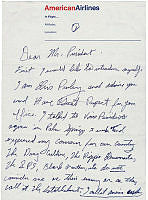Rubenstein Center Scholarship
A White House Maid Remembers a Moment of Panic

Maggie Rogers’s handwritten notes.
For evening receptions, Grace Coolidge favored gowns with trains. Columnist Vylla Poe Wilson remarked in January 1926, " Mrs. Coolidge does not let the fact that she wears a train . . . interfere with the careful line of the gown itself. . . . [It] is never allowed to drag the gown."1
Maggie Rogers, who served as Grace Coolidge's maid, regularly ensured that the First Lady's costume was in order before the Coolidges greeted their guests. One night, as Mrs. Coolidge came down the grand stair, the first lady tossed her train over her arm. Rogers could not see the train. She was seized with anxiety, fearing that it might be caught on something, or that it had been left upstairs. Just then, Mrs. Coolidge let the train fall to the floor. Rogers straightened the flowing fabric, and the Coolidges went into the Parlor. But the experience left Rogers "[panicky] for the rest of the evening."
Howard Chandler Christy painted a portrait of First Lady Grace Coolidge in 1924. It hangs in the China Room of the White House. Mrs. Coolidge wears a red dress with a train. The First Lady presented this dress to Maggie Rogers; her daughter, Lillian Rogers Parks, wore it often.2






























































